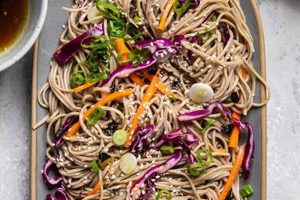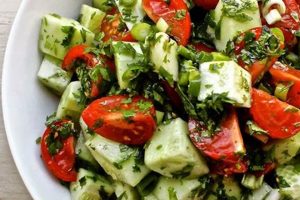A superior Italian olive salad typically features a vibrant mix of high-quality olives (such as Castelvetrano, Cerignola, and Kalamata), along with other flavorful ingredients. These often include pickled vegetables like carrots, celery, and cauliflower, as well as giardiniera. Aromatic additions like garlic, oregano, and red pepper flakes contribute depth, while capers and pepperoncini provide a tangy kick. A simple vinaigrette, often composed of extra virgin olive oil and red wine vinegar, binds the ingredients together. This versatile condiment can be enjoyed as an antipasto, a topping for sandwiches and salads, or an accompaniment to grilled meats and cheeses.
The appeal of a well-executed olive salad lies in its balance of flavors and textures: briny olives, crisp vegetables, pungent aromatics, and a bright, acidic dressing. Historically, preserving olives and vegetables in oil and vinegar was a practical method of extending their shelf life, particularly in Mediterranean climates. This culinary tradition has evolved into a celebrated appetizer and accompaniment across cultures. Beyond its deliciousness, olive salad offers nutritional value with healthy fats from olive oil, vitamins, and antioxidants from the vegetables and olives.
This article will explore various approaches to crafting exceptional olive salads, encompassing diverse ingredient combinations, preparation techniques, and serving suggestions. Discussions will range from selecting the finest olives and vegetables to balancing flavors and achieving optimal texture. Whether seeking a traditional recipe or a contemporary interpretation, readers will discover valuable insights to elevate their olive salad creations.
Tips for Crafting an Exceptional Italian Olive Salad
Elevating an Italian olive salad from simple to exceptional hinges on careful ingredient selection and thoughtful preparation. The following tips offer guidance on achieving optimal flavor and texture.
Tip 1: Olive Selection is Paramount: Opt for a medley of olives, considering variations in size, color, and brininess. Castelvetrano, Cerignola, and Kalamata olives offer a compelling combination of flavors and textures.
Tip 2: Freshness Matters: Prioritize fresh, high-quality vegetables. If using pre-pickled vegetables, ensure they are crisp and vibrant, not overly soft or mushy.
Tip 3: Balance is Key: Achieve a harmonious blend of flavors by incorporating salty olives, tangy pickled vegetables, pungent aromatics, and a bright, acidic dressing.
Tip 4: Aromatic Enhancement: Garlic, oregano, red pepper flakes, and other herbs and spices add depth and complexity. Consider toasted fennel seeds or a pinch of crushed red pepper for added warmth.
Tip 5: The Art of the Vinaigrette: A simple vinaigrette of extra virgin olive oil and red wine vinegar forms the foundation. Experiment with additions like lemon zest, Dijon mustard, or a touch of honey for nuanced flavor.
Tip 6: Marination Enhances Flavor: Allow the salad to marinate for at least a few hours, or preferably overnight, in the refrigerator. This allows the flavors to meld and deepen.
Tip 7: Texture Considerations: Achieve a desirable textural contrast by combining firm olives with crisp vegetables. Avoid over-marinating, which can lead to mushiness.
Tip 8: Proper Storage: Store the olive salad in an airtight container in the refrigerator for up to a week. The flavors will continue to develop over time.
By adhering to these guidelines, one can create an Italian olive salad that showcases the vibrant flavors and textures characteristic of this classic condiment. Proper technique and attention to detail yield a truly exceptional result.
This exploration of olive salad preparation provides a foundation for crafting memorable culinary experiences. The following conclusion will offer final thoughts and inspire further experimentation.
1. High-quality Olives
High-quality olives form the cornerstone of a truly exceptional Italian olive salad. The olives contribute significantly to the overall flavor profile, texture, and visual appeal. Their quality directly impacts the final result. Employing inferior olives, regardless of other ingredient quality or meticulous preparation, invariably yields a subpar outcome. Conversely, premium olives elevate the entire salad, providing a robust and nuanced flavor experience.
Several factors distinguish high-quality olives. These include the olive variety, curing process, and overall freshness. For example, Castelvetrano olives offer a buttery, mild flavor and delicate texture, while Kalamata olives possess a rich, briny, and slightly fruity taste. Cerignola olives, known for their large size and firm texture, contribute a meaty flavor. The curing process, whether salt-cured, oil-cured, or water-cured, further influences the olive’s flavor and texture. Freshness also plays a crucial role; olives should be plump, vibrant in color, and free from blemishes. Selecting a mix of olive varieties provides a complex and interesting flavor profile.
Understanding the importance of olive quality empowers informed ingredient selection. Choosing high-quality olives ensures a superior foundation for the salad, allowing other ingredients and preparation techniques to shine. Ultimately, investing in premium olives is an investment in the overall quality and enjoyment of the final dish. The difference between using exceptional olives and standard supermarket varieties is often readily discernible in the final product’s depth of flavor and overall complexity.
2. Fresh, Crisp Vegetables
Fresh, crisp vegetables are essential for a high-quality Italian olive salad. They provide textural contrast to the olives and contribute brightness and complexity to the overall flavor profile. Without these crisp elements, the salad can become overly rich and one-dimensional. The selection and preparation of vegetables significantly influence the final product’s appeal.
- Variety and Selection
A diverse range of vegetables enhances both the flavor and visual appeal. Common choices include carrots, celery, bell peppers, cauliflower, and fennel. Selecting vegetables at peak freshness is crucial. Look for vibrant colors, firm textures, and an absence of blemishes or bruising. The variety of vegetables chosen directly impacts the nutritional value and complexity of the salad.
- Preparation Techniques
Proper preparation techniques maintain the vegetables’ crispness and optimize their flavor contribution. Cutting vegetables into uniform sizes ensures even marinating and a consistent texture throughout the salad. Blanching certain vegetables, such as cauliflower or carrots, can enhance their color and slightly soften their texture without compromising their crispness. Careful chopping prevents excessive bruising and maintains the integrity of the vegetables.
- Balancing Flavors and Textures
Balancing the flavors and textures of the chosen vegetables is vital. Consider incorporating both mild and more assertive flavors, such as combining sweet bell peppers with peppery radishes. Varying textures, such as pairing crunchy carrots with slightly softer marinated artichoke hearts, adds complexity and interest. The interplay of textures creates a more dynamic and enjoyable culinary experience.
- Marination and Storage
The marination process influences the vegetables’ texture and flavor absorption. While marinating allows flavors to meld, excessive marination can lead to overly softened vegetables. Proper storage, in an airtight container in the refrigerator, maintains freshness and prevents spoilage. Monitoring the marination time helps to preserve the desired texture and prevent the salad from becoming overly saturated with the marinade.
The careful selection, preparation, and incorporation of fresh, crisp vegetables are indispensable to a superior Italian olive salad. Their contribution goes beyond mere texture, enhancing the overall flavor profile, visual appeal, and nutritional value. The interplay between the crisp vegetables and the other components, such as the olives and vinaigrette, ultimately determines the salad’s success. Attention to these details elevates the salad from a simple side dish to a more complex and satisfying culinary creation.
3. Balanced Vinaigrette
A balanced vinaigrette is crucial to a best Italian olive salad recipe. It provides the acidic element that cuts through the richness of the olives and other ingredients, while also contributing to the overall flavor profile and texture. The vinaigrette acts as a unifying element, binding the individual components into a cohesive and harmonious whole. Without a properly balanced vinaigrette, the salad can become overly oily or lack the necessary brightness and complexity.
- Acidity
The acidity level is paramount. It should be pronounced enough to cut through the richness of the olives and other ingredients, yet not so overwhelming that it dominates the flavor profile. Traditional Italian olive salads typically employ red wine vinegar, which provides a robust and slightly tangy acidity. Other options include white wine vinegar, apple cider vinegar, or even lemon juice. The choice of acid impacts not only the flavor but also the overall balance of the salad. Too much acidity can make the salad taste sharp, while too little can result in a flat, oily taste. The ideal acidity level complements the other flavors, creating a harmonious and refreshing experience.
- Oil
The choice of oil significantly impacts the vinaigrette’s flavor and texture. Extra virgin olive oil is the traditional choice, offering a rich, fruity flavor that complements the olives and other ingredients. The quality of the olive oil is essential; a high-quality extra virgin olive oil will possess a more complex and nuanced flavor profile. The ratio of oil to vinegar is also crucial. A typical ratio is 3:1, but this can be adjusted to personal preference. Too much oil can make the salad heavy, while too little can result in a dry and less palatable salad. The oil also contributes to the mouthfeel of the salad, adding a smooth and luxurious texture.
- Aromatics and Seasoning
Aromatic additions and seasonings enhance the complexity of the vinaigrette. Common choices include garlic, oregano, red pepper flakes, and black pepper. These ingredients add depth and dimension to the flavor profile, complementing the olives and vegetables. The quantity of these additions should be carefully considered; too much can overpower the other flavors, while too little can result in a bland vinaigrette. Fresh herbs, such as parsley or basil, can also be added for a brighter, more herbaceous note. These aromatic additions elevate the vinaigrette beyond a simple mixture of oil and vinegar, transforming it into a flavorful and complex component of the salad.
- Emulsification and Incorporation
Proper emulsification is essential for a well-balanced vinaigrette. Whisk the oil and vinegar together vigorously to create a temporary emulsion, which helps to distribute the flavors evenly throughout the salad. Alternatively, a blender can be used to create a more stable emulsion. The vinaigrette should coat the olives and vegetables evenly, ensuring that each bite is infused with flavor. Proper incorporation prevents the oil and vinegar from separating, resulting in a more cohesive and palatable salad. The emulsification process contributes to the texture and mouthfeel of the vinaigrette, ensuring that it complements the other ingredients without being overly oily or watery.
A well-balanced vinaigrette elevates an Italian olive salad from simple to exceptional. The interplay of acidity, oil, aromatics, and emulsification creates a harmonious blend of flavors and textures that complements the other ingredients, creating a vibrant and delicious culinary experience. Achieving this balance is paramount to a truly best Italian olive salad recipe. The vinaigrette is not merely a dressing; it’s an integral component that contributes significantly to the overall quality and enjoyment of the dish. A properly executed vinaigrette transforms the individual ingredients into a unified and flavorful whole.
4. Aromatic Complexity
Aromatic complexity distinguishes a truly exceptional Italian olive salad from a merely adequate one. The interplay of various herbs, spices, and other aromatic ingredients elevates the salad’s flavor profile, adding depth and nuance beyond the foundational tastes of olives and vegetables. Achieving this complexity requires careful consideration of ingredient selection, balance, and interaction.
- Layering Aromatics
Building aromatic complexity involves layering different flavors. This might begin with a base of garlic and oregano, classic components of Italian cuisine. Adding red pepper flakes introduces a subtle heat, while a pinch of black pepper provides a contrasting pungency. Further complexity can be achieved with the addition of less common aromatics like fennel seeds, coriander, or even a touch of citrus zest. Each layer contributes a distinct nuance, creating a multifaceted flavor profile.
- Balancing Intensity
Aromatic intensity requires careful balancing. While a robust flavor profile is desirable, overpowering any single element can detract from the overall harmony. The goal is to create a symphony of flavors where each ingredient plays a distinct yet complementary role. For example, the pungent heat of red pepper flakes should not overshadow the subtle earthiness of oregano, and the bright citrus notes should not overwhelm the savory base of garlic and olives. This balance is achieved through careful measurement and tasting throughout the preparation process.
- Fresh vs. Dried Herbs and Spices
The choice between fresh and dried herbs and spices influences the final aromatic profile. Fresh herbs generally offer a brighter, more vibrant flavor, while dried herbs provide a more concentrated and often earthier taste. This distinction requires adjusting quantities; dried herbs are typically used in smaller amounts due to their concentrated flavor. In an olive salad, a combination of fresh and dried herbs can create a particularly interesting complexity. Fresh parsley or basil can provide a bright counterpoint to the deeper notes of dried oregano or thyme.
- Marination and Flavor Development
The marination period plays a crucial role in developing aromatic complexity. As the salad marinates, the flavors of the various herbs, spices, and other aromatics meld and deepen, creating a more unified and complex taste. The olive oil in the vinaigrette acts as a carrier for these flavors, distributing them evenly throughout the salad. The length of the marination period influences the final intensity of the aromatic profile; longer marinating times typically result in a more pronounced and integrated flavor.
The aromatic complexity of an Italian olive salad significantly contributes to its overall quality and appeal. A well-executed combination of herbs, spices, and other aromatics elevates the salad beyond a simple side dish, transforming it into a flavorful and nuanced culinary experience. Understanding the interplay of these elements allows for a more intentional and rewarding approach to crafting a truly exceptional olive salad. A carefully constructed aromatic profile enhances the inherent flavors of the olives and vegetables, creating a dish that is both complex and deeply satisfying.
5. Proper Marination Time
Proper marination time is crucial for achieving the best Italian olive salad. It directly impacts flavor development, texture, and overall quality. Insufficient marination results in a salad where the flavors haven’t fully melded, while excessive marination can lead to mushy vegetables and an overly intense flavor profile. The optimal marination time allows the ingredients to harmonize, creating a balanced and delicious final product.
- Flavor Fusion
Marination allows the diverse flavors of the olives, vegetables, aromatics, and vinaigrette to meld together. The oil in the vinaigrette acts as a carrier for these flavors, facilitating their distribution and integration. Over time, the individual flavors become less distinct, creating a more complex and unified taste. The acidic component of the vinaigrette also plays a role in this process, breaking down some of the vegetables’ cell walls and allowing them to absorb the surrounding flavors more readily. A properly marinated salad exhibits a harmonious blend of flavors, where the individual components contribute to a greater whole.
- Texture Optimization
Marination influences the texture of the vegetables in the salad. The acidic component of the vinaigrette can soften vegetables over time. While some softening is desirable, excessive marination can lead to mushy, unappetizing vegetables. The ideal marination time achieves a balance between flavor infusion and texture preservation. The vegetables should retain a pleasant crispness or firmness, providing textural contrast to the olives. The marination time needs to be carefully calibrated to achieve this balance, as different vegetables have varying sensitivities to acid.
- Temperature Considerations
Temperature plays a significant role in the marination process. Marinating at room temperature accelerates flavor development and softening, while refrigerating the salad slows down these processes. Room temperature marination might be suitable for shorter durations, but for longer marinades, refrigeration is essential to prevent bacterial growth and spoilage. The ideal temperature also depends on the specific ingredients and the desired outcome. For example, a salad with delicate herbs might benefit from a shorter, cooler marination to preserve their fresh flavors.
- Recipe Variations and Marination Time
Specific recipe variations can influence optimal marination time. Salads with more robust flavors or heartier vegetables may require longer marinating times to fully develop their flavors and achieve the desired texture. Conversely, salads with delicate ingredients or milder flavors might benefit from shorter marinades to prevent overpowering or over-softening. Adapting the marination time to the specific ingredients and desired outcome is crucial for achieving the best result. Consulting similar recipes or established guidelines can provide a starting point, but experimentation and tasting are often the best ways to determine the ideal marination time for a particular recipe.
Proper marination time is essential for maximizing the flavor and texture of an Italian olive salad. Understanding the interplay of flavor fusion, texture optimization, temperature considerations, and recipe variations allows for precise control over the final product. The ideal marination time ensures that the individual ingredients harmonize into a balanced, flavorful, and texturally appealing salad. A well-marinated olive salad demonstrates the transformative power of time and careful technique, elevating simple ingredients into a truly exceptional dish.
6. Textural Variation
Textural variation is a hallmark of a superior Italian olive salad. It elevates the sensory experience beyond mere taste, engaging the consumer with a dynamic interplay of contrasting consistencies. A successful olive salad avoids uniformity, instead offering a stimulating combination of firm, crisp, and yielding elements. This textural diversity contributes significantly to the overall enjoyment and perceived quality of the dish.
Olives themselves offer a foundational textural element, ranging from the firm, meaty texture of Cerignola olives to the more yielding, buttery consistency of Castelvetrano olives. The selection of vegetables further enhances this diversity. Crisp celery and carrots provide a satisfying crunch, contrasting with the softer textures of marinated artichoke hearts or roasted red peppers. The inclusion of elements like toasted nuts or breadcrumbs can introduce an additional layer of textural complexity, contributing a welcome contrast to the other ingredients. Consider, for example, the interplay between plump, oil-cured olives, crunchy giardiniera, and slightly chewy sun-dried tomatoes: this combination offers a compelling textural tapestry that elevates the salad beyond a simple mix of ingredients.
Achieving optimal textural variation requires careful consideration of ingredient selection and preparation techniques. Blanching certain vegetables can modify their texture without compromising their structural integrity. Chopping vegetables into varied sizes and shapes, rather than uniformly dicing them, contributes visual and textural interest. Furthermore, the marination process itself influences texture. Over-marination can lead to undesirably soft vegetables, while insufficient marination may not allow for optimal flavor infusion. Balancing these factors is essential for creating an olive salad that offers a complex and satisfying textural experience. This attention to detail elevates the dish, showcasing the culinary expertise of the preparer and enhancing the overall enjoyment for the consumer. The textural dimension of an Italian olive salad underscores the importance of considering all sensory aspects when crafting a truly exceptional culinary experience.
7. Optimal Storage Practices
Optimal storage practices are integral to maintaining the quality and extending the lifespan of a best Italian olive salad recipe. Proper storage preserves the vibrant flavors, crisp textures, and visual appeal of the salad, ensuring a consistently enjoyable culinary experience. Neglecting these practices can lead to flavor degradation, textural deterioration, and potential spoilage, compromising the overall quality of the carefully crafted dish. The connection between optimal storage and a high-quality olive salad is demonstrably direct; appropriate storage safeguards the investment of time and resources dedicated to creating a superior culinary product.
Several factors contribute to optimal olive salad storage. An airtight container is essential for preventing oxidation and preserving freshness. Exposure to air can lead to the development of off-flavors and a decline in textural quality, particularly in the vegetables. Refrigeration is crucial for inhibiting microbial growth and maintaining the integrity of the ingredients. The ideal storage temperature, typically between 34F and 40F (1C and 4C), slows down enzymatic activity that can lead to spoilage. Avoid storing the salad near strong-smelling foods, as the olive oil can absorb these odors, negatively impacting the salad’s flavor profile. For instance, storing an olive salad next to cut onions or garlic can impart unwanted pungency to the delicate flavors of the olives and other vegetables. Proper labeling with the preparation date allows for effective inventory management and ensures consumption within a safe timeframe. Most olive salads can be safely enjoyed for up to a week when stored correctly, though flavor and texture may begin to subtly decline after the first few days.
Implementing optimal storage practices demonstrates a commitment to culinary excellence and food safety. By prioritizing these practices, one safeguards the investment in high-quality ingredients and careful preparation techniques. A properly stored olive salad consistently delivers the intended flavors and textures, enhancing the dining experience. Conversely, neglecting these practices can compromise even the most meticulously crafted recipe. Understanding the significance of proper storage reinforces the interconnectedness of various culinary practices and highlights the importance of attention to detail in achieving optimal culinary outcomes. Effective storage is the final, crucial step in ensuring that a best Italian olive salad recipe reaches its full potential.
Frequently Asked Questions
This section addresses common inquiries regarding the preparation and enjoyment of high-quality Italian olive salad.
Question 1: What types of olives are most suitable for Italian olive salad?
While a variety of olives can be used, certain types are particularly well-suited for Italian olive salad. Castelvetrano olives offer a buttery, mild flavor, while Cerignola olives provide a firm, meaty texture. Kalamata olives contribute a rich, briny taste. A mixture of these varieties creates a complex and balanced flavor profile.
Question 2: Can one substitute jarred giardiniera for fresh vegetables?
Jarred giardiniera offers convenience and can be a suitable substitute for fresh vegetables. However, high-quality jarred giardiniera is crucial. Look for products with vibrant colors, crisp textures, and a balanced brine. Freshly prepared vegetables generally offer superior flavor and texture.
Question 3: How long should the olive salad marinate?
Optimal marination time ranges from a few hours to overnight. This allows the flavors to meld and intensify. Longer marination periods may soften the vegetables excessively. Refrigeration is recommended for extended marinades.
Question 4: What is the best way to store Italian olive salad?
Store the salad in an airtight container in the refrigerator. This prevents oxidation and maintains freshness. Proper storage preserves the salad’s flavor and texture for up to a week.
Question 5: Can one adjust the vinaigrette’s acidity?
The vinaigrette’s acidity can be adjusted to suit individual preferences. Adding more vinegar intensifies the tanginess, while reducing the vinegar creates a milder flavor. Lemon juice can also contribute acidity.
Question 6: How can one enhance the aromatic complexity of the salad?
Aromatic complexity can be enhanced through the judicious use of herbs and spices. Fresh or dried oregano, garlic, red pepper flakes, and black pepper are common additions. Experimenting with other spices, such as fennel seeds or coriander, can further elevate the flavor profile.
Careful attention to ingredient selection, preparation techniques, and storage practices ensures a high-quality Italian olive salad. These considerations impact the final product’s flavor, texture, and overall appeal.
The following section provides recipe variations for exploring diverse flavor profiles and ingredient combinations.
Best Italian Olive Salad Recipe
Exploration of the best Italian olive salad recipe reveals the critical interplay of high-quality ingredients, precise techniques, and thoughtful flavor balancing. Olive selection, vegetable preparation, vinaigrette composition, aromatic layering, and appropriate marination contribute synergistically to the final product. Optimal storage practices safeguard the realized quality. Each element, from olive variety to herb selection, represents an opportunity to elevate the sensory experience. This understanding empowers culinary refinement, transforming a simple condiment into a sophisticated expression of flavor.
The pursuit of the best Italian olive salad recipe transcends mere ingredient assembly; it represents a commitment to culinary excellence. Attention to detail and a nuanced understanding of flavor dynamics unlock the full potential of this classic preparation. Continued exploration and experimentation promise further refinement and personalized interpretations, enriching the culinary landscape and perpetuating the legacy of this versatile and flavorful dish.






